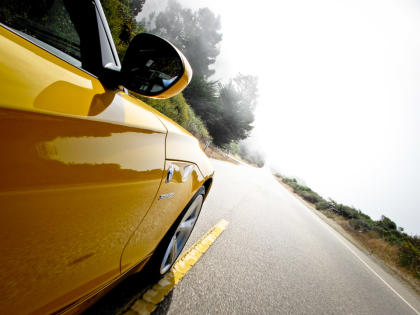First Drive: 2012 BMW Z4 sDrive28i
The beginning of the end of BMW’s signature engine starts here.
MORE AT YAHOO! AUTOS
The paterfamilias of all sporting BMWs is the 328 of 1936-40. Produced in limited numbers and featuring advanced-for-the-era technologies, it won the Mille Miglia outright in 1940 and took its class at Le Mans in ‘39 — placing a respectable fifth overall. After the World War II, the Bayrische Motoren Werke were in shambles, crushed by Western air power and the seemingly limitless manpower of the Red Army. They started over by building pots, pans, bikes, motorcycles and a tiny car licensed from an Italian refrigerator company called Iso. The resultant BMW Isetta helped get the company back on its feet; 40 years after the cessation of hostilities, the Munich-based concern stood as the de-facto performance sedan manufacturer. Yet what of the lightweight sporting machines that had made the company a force to be reckoned with just before the war forced the them to reboot?
While BMW had been considering a lightweight roadster since the mid-1980s and offered one in limited numbers to Europeans from ‘89-91 in the form of the odd, wonderful Z1 (see sidebar), when the Z3 arrived on our shores for the ‘96 model year, the four-cylinder roadster underwhelmed buyers; it gained a reputation as a chick car that even the later addition of one of BMW’s straight sixes couldn’t reverse. In 2003, the company abandoned the Z3’s alphanumeric appellation in favor of Z4 — as Nigel Tufnel would say, “It’s one louder, innit?” The name change didn’t do much to shift the model’s reputation. Now, after introducing the second-generation in 2009 with only six-cylinder engines, the base-model 2012 Z4 sDrive28i is moving to four-cylinder power. Cue scratching-record noise, Wilhelm scream, etc.
The straight six, after all, is BMW’s calling card, no? Not anymore. In the brave new world of increasingly strict economy and emissions standards, the company may as well change its name to Bayrische Turbolader Werke, as naturally-aspirated engines are fast becoming a rare breed in the company’s lineup. The turbo four in the sDrive28i strives to maintain a similar power level to the outgoing six, offering 240hp (15 less) and 260 lb-ft of torque (40 more). What’s more, the shorter engine allowed BMW to move the center of mass toward the middle of the car, which makes for more nimble handling. It’s the same reason that Porsche puts the engine in the middle of the Boxster. The four-banger’s connected to your choice of an eight-speed automatic or a six-speed manual transmission.
What better way to check out all this assembled kit than by a blast from Monterey down Highway 1 to Pismo Beach? Traffic, broken asphalt, cyclists, temperature changes, variable visibility and now and then, a stretch of gloriously smooth pavement with dips, rises, twists and turns accompanied by sweeping vistas of the Pacific Ocean all come as part of the standard 150-mile package. How was it? In a word, fun. Not uproarious, unmitigated delight, but plenty of solid, Germanic fun. The new engine seems very well-matched to the chassis and there’s just enough of the car left unbuttoned to make you feel like a bit of a behind-the-wheel hero.
The previous day, I’d taken a spin in BMW’s new 650i Coupe. (See our review of the convertible here.) The big four-place GT’s recipe for overcoming any problem seemed to be application of brute force. Yes, it was sure-footed, yes, it was fast, but there was no joy or sense of involvement in the proceedings. The Z4, on the other hand, requires enough thought to be engaging. Part of the reason aficionados of cars like the Mazda Miata and Porsche 914 obsess over such tiny, minimal-output machines is that driving them requires continual problem-solving. As in, “I have x amount of power and y amount of road. If I apply a% of throttle combined with c degrees of steering at point z, I have a 65% of passing this car without causing an accident. If I apply b% of throttle and drop down one gear, my odds of a successful pass increase to 95%.” If your eyes just glazed over, don’t worry, you’ll probably still enjoy the Z4 very much. After all, the new four’s power figures were once good enough for V8 ponycars. In essence, if you want to get the most of of the sDrive28i, a little pre-algebra may be required, but it doesn’t mean that an obsession with differential equations is a prerequisite.
There’s really just one glaring problem with the Z4. The base price of $49,525 is slightly higher than another German-engineered droptop two seater. One with a naturally-aspirated flat-six powerplant from an outfit that’s been constructing an unbroken line of sports cars since 1948. One which also offers more storage space in its twin trunks. It’s the venerable Porsche Boxster and it starts at $48,100. Owing to its folding hardtop, the Z4 offers a paucity of cargo room, making top-down weekend getways light-luggage-only propositions. Still, it’s hard to beat the Z4’s looks. Much has been made of the fact that the roadster was designed by an all-female team, yet It’s the first wholly unisex rendition of the Z3/Z4 line. I’d even go so far as to say that it’s currently the most attractive car the Munich-based concern produces.
Boxster vs. BMW aside, the point of real import here is the motor. Along with the Z4, the 2.0 turbo also appears in the 5 Series this fall as the base engine. When the 2012 3 Series debuts, expect a variant to replace that car’s base 6 as well. The classic naturally-aspirated inline six may have served the company well for decades, but as they did in the late 1940s, the times dictate a shift to ensure survival. As such, BMW’s signature powerplant is walking dead, long live the turbo four.

 Yahoo Autos
Yahoo Autos 





